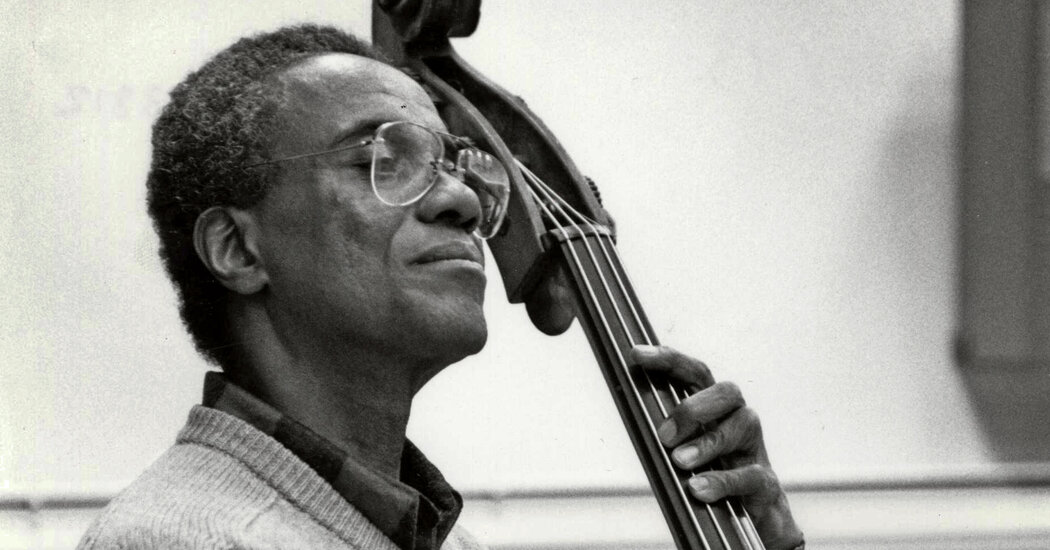
Richard Davis, an esteemed bassist who played not just with some of the biggest names in jazz but also with major figures in the classical, pop and rock worlds, died on Wednesday in Madison, Wis. He was 93.
His death was announced by Persia Davis, his daughter, who said he had been in hospice care for the last two years.
Mr. Davis, who was named a National Endowment for the Arts Jazz Master in 2014, appeared on more than 600 albums. A first-call player for some of the most important figures in jazz history, he had fruitful collaborations with the reed player Eric Dolphy (whose composition “Iron Man” was named for him) and the pianist Andrew Hill. He was a member of the Thad Jones-Mel Lewis Orchestra, which performed every Monday night at the Village Vanguard in New York, from the ensemble’s debut in 1966 until 1972.
His advanced technique, especially with the bow, led to work with classical orchestras under Igor Stravinsky and Leonard Bernstein. His adaptability resulted in sessions with Van Morrison, Bruce Springsteen, Paul Simon and Bonnie Raitt.
Mr. Davis made 30 albums as a leader or co-leader from 1967 to 2007. He was named best bassist in the DownBeat magazine readers poll from 1968 to 1972.
Reviewing a 1986 performance at Sweet Basil in Greenwich Village by a band led by Mr. Davis and featuring Freddie Waits on drums, the New York Times music critic Robert Palmer wrote: “The relaxed, slightly behind-the-beat swing typical of so many jazz rhythm sections is not for them. Their accents fall right up on top of the beat, and they vary their springy forward momentum with rhythmic whirlpools and rapids and an explosive sense of dynamics.”
Richard Davis was born on April 15, 1930, in Chicago. His mother died in childbirth, and he was adopted by Robert and Elmora Johnson. He was exposed to music through the records his mother had collected in her native New Orleans and the hymns Mr. Johnson would sing around the house.
He attended DuSable High School in Chicago, where he studied music under Walter Dyett, who mentored many future jazz stars, and he started playing the bass at 15. As he recalled in a 2013 interview published in the American Federation of Musicians magazine Allegro: “I was just enthralled by the sound. The bass was always in the background and I was a shy kid. So I thought maybe I’d like to be in the background.”
Mr. Davis credited Mr. Dyett with pushing him to play across styles, and during high school he also studied with Rudolf Fahsbender of the Chicago Symphony Orchestra. He would go on to receive a bachelor’s degree in music education from the VanderCook College of Music in Chicago in 1952.
As a young player in Chicago, he was mentored by local bassists like Wilbur Ware and Eddie Calhoun. While still in college, he performed with the pianist and bandleader Sun Ra, who at the time was still billed as Sonny Blount.
His first major gig was with the pianist Ahmad Jamal in 1952. He then went on the road with another pianist, Don Shirley (whose story was told in the movie “Green Book”); this led to his initial recordings and eventually to his move, in 1954, to New York, where he worked with the singer Sarah Vaughan from 1957 to 1962.
In a 2005 interview for The New York City Jazz Record, Mr. Davis spoke of how he used aspects of his classical study and his time with Ms. Vaughan to create his particular bowing technique:
“Some of the first bass players used the bow to play the walking bass line. And I heard all of that coming up as a kid. Therefore, when you start to study books of bass methods, you start out with the bow no matter what your intentions are, so there must be some intertwining of what I heard as a kid, what I heard working with Sarah Vaughan, wanting to imitate those vocal sounds.”
After his time with Ms. Vaughan, Mr. Davis’s reputation began to grow rapidly, as did his discography. The year 1964 was an especially significant one; he played on Mr. Dolphy’s last studio recording, “Out to Lunch!”; Mr. Hill’s seminal “Point of Departure”; the drummer Tony Williams’s first album, “Life Time”; and the saxophonist Booker Ervin’s “The Song Book.”
Three years later, Mr. Davis made his first album under his own name, “Heavy Sounds,” on which he and the drummer Elvin Jones were co-leaders, released on the Impulse! label. Over the next several years, his work outside the jazz world expanded: His credits included acting as musical director for Mr. Morrison’s album “Astral Weeks” and providing the haunting bow work at the end of “The Angel,” on Mr. Springsteen’s album “Greetings From Asbury Park, N.J.”
Mr. Davis continued to release albums regularly through the new millennium. In the late 1960s and ’70s he was also a member of the New York Bass Violin Choir, led by his fellow bassist Bill Lee, playing alongside other luminaries of the instrument like Ron Carter, Milt Hinton and Sam Jones. In the late 1980s he was a founding member of New York Unit, a trio with the pianist John Hicks and the drummer Tatsuya Nakamura, which recorded eight albums for Japanese labels through 1998.
In an email, Mr. Carter said Mr. Davis was “an incredible bassist, a great teacher and my dear friend.”
In 1977, Mr. Davis left New York to take a position as a professor of music and music history at the University of Wisconsin-Madison. “I got a call offering me a job at the university in Madison because they didn’t have a bass teacher on campus,” he told OnWisconsin, the university’s alumni magazine, in 2011. “I said, ‘Where’s Madison?’ I asked around if anyone had heard of the place because this school kept calling me. Martin Luther King Jr. talked about the importance of teaching others, and I had always wanted to teach young people. I thought maybe it was time.”
He retired from teaching in 2016. In 2018, Richard Davis Lane in eastern Madison was named in his honor.
Complete information on survivors was not immediately available.
In addition to his recorded work and his influence on generations of students, Mr. Davis leaves behind two legacies — one musical, the other societal.
The Richard Davis Foundation for Young Bassists, which he created in 1993, conducts an annual conference for young players to learn from professionals and perform with one another. And in 2000, Mr. Davis established the Madison chapter of the Center for the Healing of Racism, an outgrowth of his founding in 1998 of the Retention Action Project at the University of Wisconsin to improve graduation rates for students of color.
His activism was connected to his earliest experiences trying to be a classical player., he said in the 2005 interview:
“My environment with race issues started the day I was born. You’re born with dark skin, and that itself brings on attitudes of other people who are not dark-skinned to see you as someone to be oppressed and not to be given equal chances in society. So that is something that is permanent.
“I was 18 years old and I could play any and all of the European classical music,” he continued, “but you weren’t allowed to participate in the symphony orchestra because there were racial issues and prejudices. They didn’t want to see you.”
The bassist William Parker, who studied with Mr. Davis as a young man in New York, said: “Richard Davis was a beautiful musician and human being. He reminded me of an African king, regal and strong. I praise him not because he could play both classical and jazz. I applaud him because the brother had a big, poetic sound full of freedom.”
Mr. Davis, he added, “taught me some things about music, but his main message was ‘Be yourself.’”













